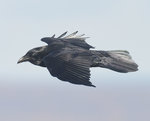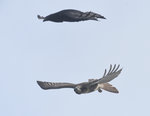 Narrowsburg
NarrowsburgLight Rain Fog/Mist, 43°
Wind: 8.1 mph
 Narrowsburg
NarrowsburgAnyone who has been outside, whether on a woodland trail or beside the river, has probably gotten to see or hear a raven. Slightly bigger and more stout than the American crow, ravens can be spotted …
Stay informed about your community and support local independent journalism.
Subscribe to The River Reporter today. click here
This item is available in full to subscribers.
Please log in to continue |


Anyone who has been outside, whether on a woodland trail or beside the river, has probably gotten to see or hear a raven. Slightly bigger and more stout than the American crow, ravens can be spotted in a variety of areas, especially near cliffs or rock outcrops. The common raven is often heard before it is seen; its call is lower than the “caw-caw” of a crow. It also has a repertoire of “gronks” and brief single clucks called “rattles.” Perhaps the raven’s vocalizations helped build upon folklore of this species having supernatural qualities.
In Edgar Allan Poe’s poem, “The Raven,” a raven shows up at a gentleman’s door one late December evening, and, of course, the man tries to strike up a conversation. He asks the raven if he will ever see his lost love, Lenore, again. The raven replies, “Nevermore.” More exchanges take place with the raven uttering the same reply, “nevermore.”
In real life, watching ravens can be rather fun. They are bold and inquisitive members of the Corvidae family, which also includes crows, jays and magpies. In flight, they exhibit a graceful, raptor-like quality. They are frequently spotted soaring on thermals and near ridges. They engage in chasing each other as well as raptor species in play. Immature red-tailed hawks are quick to join in, and they may be seen playing with each other for 20 minutes or more. Ravens are good at aerobatics; they may suddenly roll and go into a steep dive, or “stoop.”
When looking for food, they use some intelligent methods. Ravens will sometimes follow other species of birds in order to locate nests to raid. Even bald eagle nests are not immune if the eggs are left unattended (another reason not to venture too close to eagle nests and cause the incubating adult to leave). If there is carrion to be found, ravens will share the feast with eagles, not giving up their feeding spot until the eagles get very close.
Ravens help do “cleanup duty” for road-killed deer and other carrion; they fill a slot left by the vultures, which migrate out of the region for the winter. They do, however, get a bad rap for being noisy, nuisance birds, likely for being grouped in with crows. But are these corvids really supernatural or evil? “Nevermore,” quoth the raven.
Comments
No comments on this item Please log in to comment by clicking here